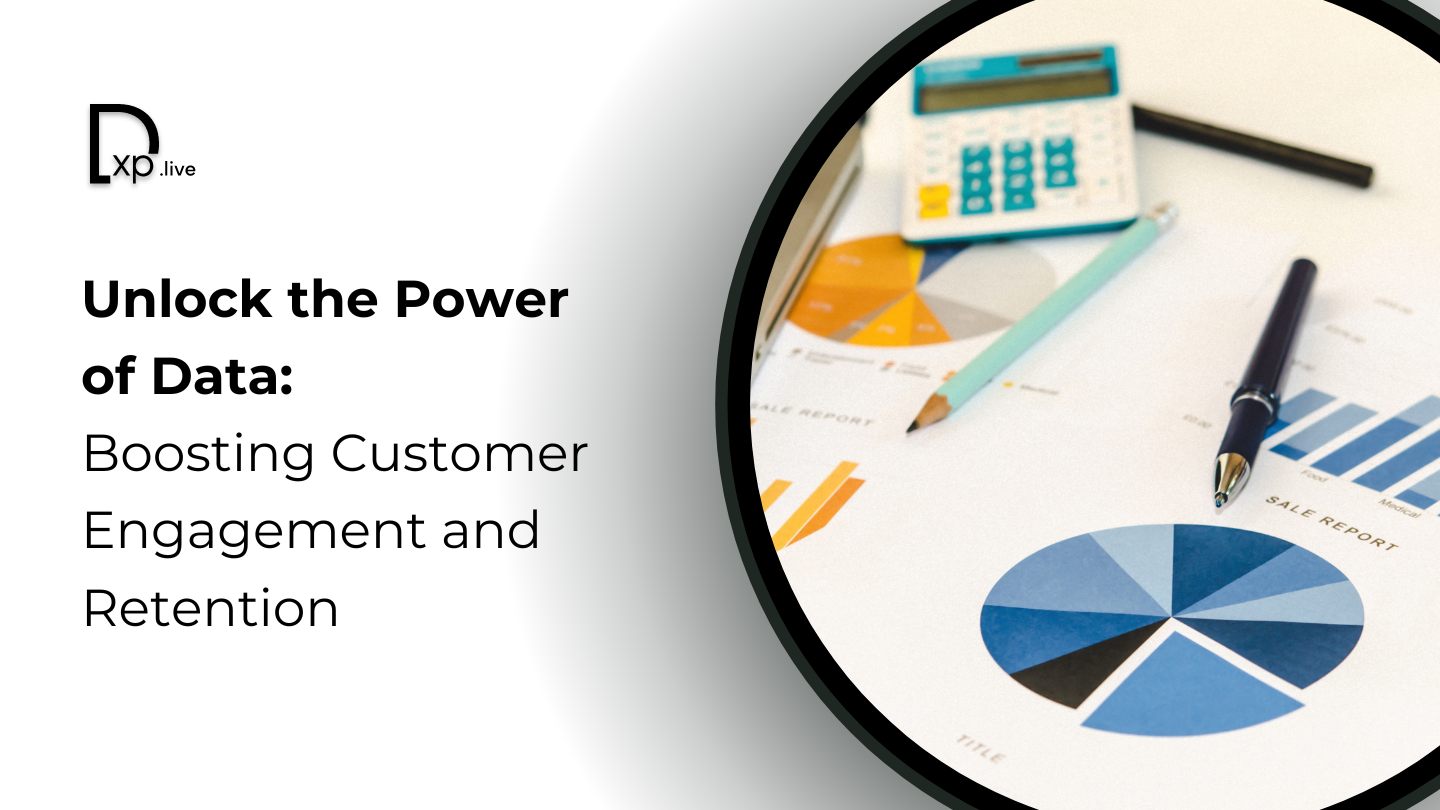Unlock the Power of Data: Boosting Customer Engagement and Retention

Customer engagement, customer behavior, and customer retention have become the buzzwords for today’s hyper-competitive and hyper-personalized world. While the brands vie for customer loyalty, they have accepted one fact- delivering an exceptional customer experience is the foundation of it. But how? That’s the part where most brands fumble or make mistakes. Well, engaging customers at the right time and with the right strategy might be the biggest pain point, but the solution is data analytics.
Data is the blood of any business, and why? Data-driven insights can boost a brand’s insight into creating personalized interactions. Data can also anticipate customer journeys and needs, thus enhancing overall customer experience (CX). This is essential not just for customer engagement, but also to foster long-term relationships and loyalty. In this blog, we will talk about leveraging data analytics to transform customer engagement strategies and boost retention rates.
The Data-Driven Engagement Revolution
The marketing strategies where one template fits all your needs no longer remain applicable today. Each customer is your unique template design. Creating personalized experiences for each customer and designing marketing for individual preferences is the need of the hour because hyper-personalization is what they expect from brands now. But how is that possible, you may wonder!
Data analytics enables businesses to track customer behavior, analyze patterns, and tailor interactions accordingly.
Segmentation for Precision:
Data analytics allows companies to segment their audience based on various factors such as demographics, purchase history, and browsing patterns. By understanding these nuances, brands can create personalized marketing campaigns that resonate with different customer groups. For instance, a fitness brand could target its younger customers with promotions for trendy workout gear while offering older customers discounts on recovery supplements.
Predictive Analytics:
Predictive analytics takes segmentation to the next level by analyzing historical data to forecast future behavior. It helps businesses anticipate customer needs, enabling proactive engagement. For example, an e-commerce platform can use predictive analytics to identify when a customer is likely to repurchase a product and send timely reminders or special offers.
Pro Tip:
Start with clean, well-organized data. Having accurate data allows you to create effective segments and generate meaningful insights. Invest in data quality management to maximize your analytics efforts.
Turning Insights Into Personalization

Personalization is more than just addressing customers by their first name in an email. It’s about delivering a seamless, tailored experience across all touchpoints. Data analytics provides the backbone for personalization by uncovering insights into customer preferences, behavior, and interactions.
Tailored Content:
With data analytics, brands can create highly targeted content that speaks to the individual needs of each customer. Whether it’s a personalized email campaign, product recommendation, or blog post, data-driven content helps build stronger connections. Netflix and Spotify are masters of this approach, leveraging customer data to offer curated recommendations that keep users engaged.
Dynamic Customer Journeys:
Using data analytics, brands can design dynamic customer journeys that adapt to real-time behavior. If a customer lingers on a specific product page or abandons their cart, businesses can immediately engage them with relevant offers or reminders, enhancing the chances of conversion. This kind of tailored journey increases both engagement and satisfaction.
Pro Tip:
Remember that personalization should add value without being intrusive. Too many personalized messages can overwhelm customers. Focus on delivering relevant, meaningful interactions at the right time.
Real-Time Data: Driving Customer Retention

Customer retention can only be built on continuous engagement where brands aspire to provide value at each touchpoint of the customer journey. This is where real-time data analytics come into play. Ensuring that brands are responding to customer needs instantly, can help prevent churn rate and build customer loyalty.
Predictive Churn Models:
Using data analytics, brands can develop predictive churn models that identify customers at risk of leaving. By analyzing engagement metrics, purchase frequency, and customer sentiment, businesses can pinpoint the warning signs of churn early. For example, if a subscription service notices a user hasn’t logged in for a while, they can trigger a personalized retention campaign to re-engage them.
Loyalty Programs Powered by Data:
Data analytics helps optimize loyalty programs by identifying what drives engagement for different customer segments. Brands can use this insight to offer rewards or benefits that truly matter to their audience, increasing the likelihood of repeat purchases. Starbucks’ rewards program is a prime example, using data analytics to offer personalized incentives that keep customers coming back.
Pro Tip:
Implement automated alerts to monitor real-time data for potential churn indicators. This allows your team to act swiftly and launch retention strategies before it’s too late.
Using Data to Improve Customer Feedback Loops
Regular customer feedback is as essential as chasing a customer for the first-time sale of a product or service. However, data analytics can turn feedback from reactive to proactive, allowing brands to predict potential issues and respond before they escalate.
Sentiment Analysis:
Using natural language processing (NLP), brands can analyze customer feedback in real time to gauge sentiment across social media, surveys, or reviews. This gives businesses a pulse on how customers feel about their products and services, helping them identify areas for improvement. For instance, a sudden spike in negative sentiment around a product update can prompt immediate action.
Closing the Loop with Actionable Insights:
It’s not enough to collect feedback—you need to act on it. Data analytics helps prioritize customer feedback based on impact and urgency, allowing businesses to address high-priority issues faster. Over time, this approach leads to better customer satisfaction and stronger retention rates.
Pro Tip:
Consider integrating AI-driven tools for sentiment analysis to continuously monitor customer feedback. These insights will help you stay ahead of potential issues and keep your customers happy.
The Future of Customer Engagement: AI and Automation
Talk about data analytics, and the first thing that pops into mind is automation, machine learning, and AI. Evolving data analytics requirements and the next frontier in customer engagement include all these technologies. These technologies can help brands scale personalized interactions, offering hyper-relevant content and services to millions of customers simultaneously.
AI-Powered Chatbots:
Chatbots driven by AI use data analytics to provide personalized, 24/7 customer service. These bots can handle routine queries while offering product suggestions based on customer preferences and past behavior. The result? Faster responses, improved satisfaction, and deeper engagement.
Automated Customer Journeys:
With automation, brands can create seamless customer journeys without manual intervention. For example, marketing automation platforms allow businesses to trigger personalized email campaigns based on real-time customer interactions, ensuring that every touchpoint feels relevant and valuable.
Pro Tip:
Leverage AI-driven tools to handle repetitive tasks and free up your team to focus on higher-level engagement strategies. Automation will enable you to maintain a consistent, personalized experience at scale.
Data-Driven Retention: Moving Beyond Engagement
Engagement is only one part of the equation—retention is where the real value lies. Data analytics allows businesses to keep a pulse on their customer base, identify patterns that lead to churn, and continuously refine their strategies.
Customer Lifetime Value (CLV) Analysis:
Data analytics can calculate customer lifetime value (CLV), helping brands focus on their most valuable customers. By understanding which customers contribute the most to revenue, businesses can tailor engagement strategies to maximize long-term loyalty and profitability.
Proactive Retention Strategies:
Rather than waiting for customers to leave, brands can use data analytics to proactively reach out to those at risk of churn. Whether through personalized offers, loyalty rewards, or direct engagement, these proactive measures keep customers connected to the brand.
Pro Tip:
Monitor CLV and retention rates regularly to ensure your efforts are driving long-term value. A focus on retention ultimately boosts profitability and ensures sustained growth.
Data Analytics as the Key to Long-Term Success
Enhancing customer engagement and retention isn’t just about following the latest marketing trends—it’s about harnessing the power of data to understand, predict, and meet customer needs. From personalization to real-time analytics, data-driven strategies allow brands to connect with customers on a deeper level and build lasting relationships.
Ready to take your customer engagement to the next level? Embrace data analytics and unlock new opportunities for growth and loyalty.
FAQs:
1. How does data analytics improve customer engagement?
Data analytics enables businesses to segment audiences, personalize interactions, and predict customer behavior, creating more relevant and engaging experiences.
2. What are predictive churn models?
Predictive churn models use data analytics to identify customers at risk of leaving by analyzing engagement metrics, purchase patterns, and sentiment data.
3. How can businesses personalize customer experiences using data?
By leveraging customer data, brands can tailor content, offers, and communications to individual preferences, increasing engagement and satisfaction.
4. How can real-time data improve customer retention?
Real-time data allows businesses to react instantly to customer behavior, enabling timely interventions like retention offers, personalized reminders, or loyalty rewards.
5. What role does AI play in customer engagement?
AI enhances customer engagement by automating personalized interactions through chatbots, content recommendations, and dynamic customer journeys at scale.





